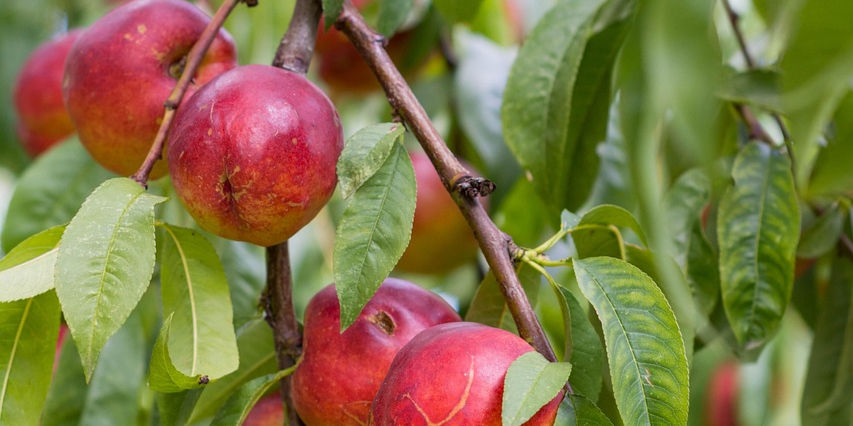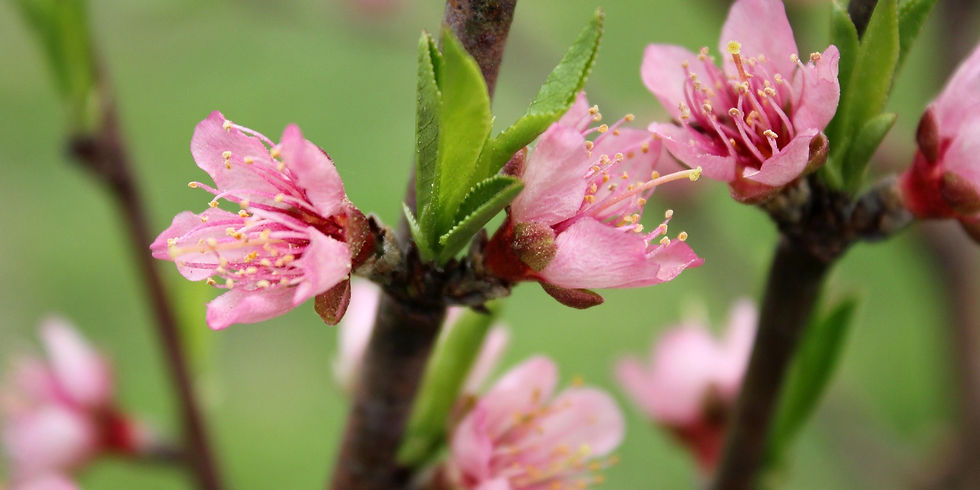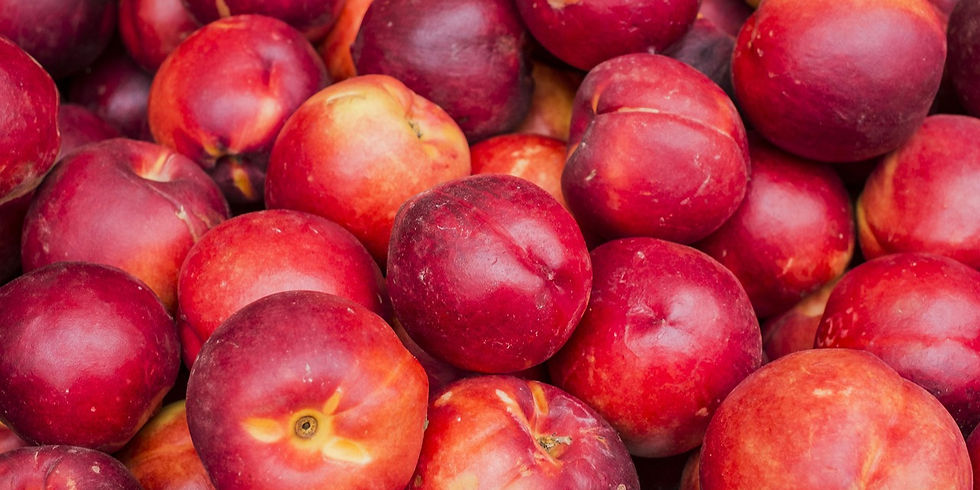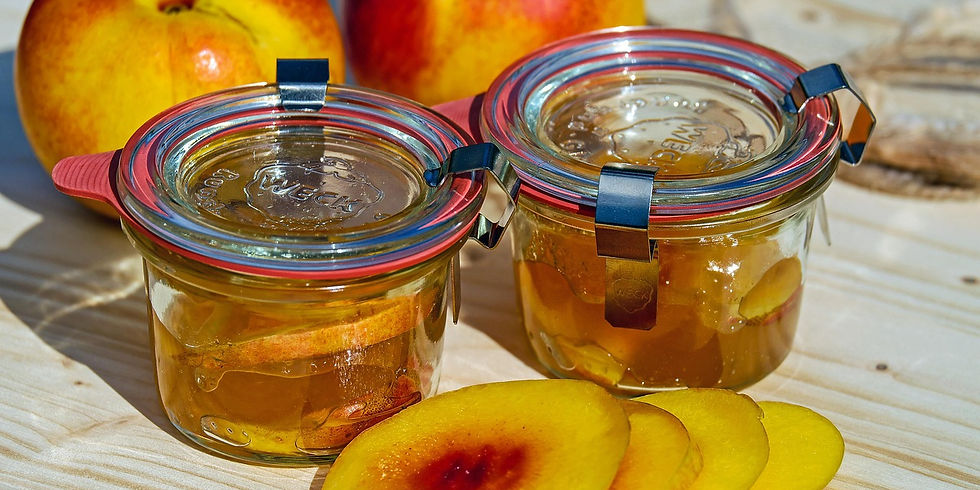Nectarine
- The Economic Botanist

- 7 hours ago
- 6 min read
Scientific name: Prunus persica L. var. nucipersica
Family: Rosaceae

You might know the nectarine as a smooth-skinned cousin of the peach, often enjoyed fresh in summer or baked into pies and jams. But beyond its sweet, juicy flesh, the nectarine is a fascinating fruit with deep roots in agriculture and culture—celebrated worldwide for its vibrant flavor and versatile uses.
In this Plant Compendium entry, we’ll guide you through everything you want to know about nectarines—from their history and botanical features to how to grow, harvest, and enjoy them in your kitchen. Whether you’re dreaming of planting a nectarine tree or just want to understand what makes this fruit so special, we’ve got you covered.
History of Nectarines
The nectarine’s story intertwines with that of its fuzzy sibling, the peach. Nectarines are essentially a genetic variant of peaches that have smooth, fuzz-free skin. The two fruits share a common ancestry but have distinct traits that have fascinated farmers and consumers alike.
Ancient Origins
Originating in China over 4,000 years ago, both peaches and nectarines were cultivated for their luscious fruit. Early Chinese texts reference these stone fruits for their sweetness and medicinal properties. The fruit traveled westward along the Silk Road, making its way to Persia and then Europe.
Spread Through the Mediterranean
By the time of the ancient Greeks and Romans, nectarines were well established in Mediterranean orchards. Roman naturalists documented the fruit’s cultivation and praised its flavor. The name “nectarine” derives from the Latin nectar, alluding to the fruit’s nectar-like sweetness.
Introduction to the Americas
Spanish explorers brought nectarines to the New World in the 16th century, planting them in California and Florida, where the climate proved ideal. Since then, nectarines have become a staple of American orchards, particularly in warm, temperate regions.
Modern Cultivation
Today, nectarines are grown worldwide, with major producers including the United States, China, Italy, and Spain. Modern breeding focuses on disease resistance, extended harvest seasons, and improved flavor and texture.
Botanical Description
Nectarines belong to the Prunus genus, alongside peaches, plums, and cherries. They share many characteristics with peaches but differ notably in their smooth skin.
Tree: Deciduous and medium-sized, nectarine trees typically grow 4 to 6 meters tall. They have a rounded canopy with spreading branches.
Leaves: Simple, lance-shaped, and serrated, leaves are a vibrant green and arranged alternately on the branches.
Flowers: Nectarine blossoms are delicate and pink, appearing in early spring before leaves emerge. They attract bees and other pollinators.
Fruit: The hallmark feature is the smooth, fuzz-free skin ranging from yellow to reddish hues. Inside, the flesh is juicy, sweet or slightly tart, and clings tightly or loosely to a single large pit or stone.

Growing Instructions
Want to grow nectarines that thrive? Here’s your cheat sheet:
Sunlight: Nectarines need full sun—at least 6 to 8 hours daily for optimal fruit production.
Soil: Well-drained, fertile loam with a slightly acidic to neutral pH (6.0–7.0) works best. Avoid waterlogged soils.
Temperature: Nectarines prefer temperate climates with cold winters to fulfill chilling requirements (about 500–1,000 chill hours). Late spring frosts can damage flowers.
Watering: Regular deep watering is essential, especially during fruit development. Avoid overwatering to prevent root rot.
Spacing: Plant trees about 4.5 to 6 meters (15–20 ft) apart to allow good air circulation.
Pruning: Annual pruning in late winter or early spring encourages healthy growth, improves airflow, and promotes fruiting.
Pollination: Most nectarine varieties are self-pollinating but benefit from nearby bee activity for better yields.
Harvesting and Foraging
Harvesting:
Nectarines are typically harvested in mid to late summer when they turn vibrant in color and yield slightly to gentle pressure. Harvest early in the day to preserve freshness.
Foraging:
Wild or feral nectarine trees are rare, but some old orchards or abandoned sites may still harbor trees. Always ensure fruit is pesticide-free before eating.

Plant Companions
Good companions for nectarine trees include:
Legumes (peas, beans) — fix nitrogen and enrich soil.
Marigolds and nasturtiums — deter pests and attract beneficial insects.
Chives and garlic — repel borers and fungal infections.
Avoid planting near large shade trees or overly aggressive plants that compete for nutrients.
Common Pests and Diseases
Be on the lookout for:
Peach twig borer: Larvae bore into twigs and fruit.
Brown rot: A fungal disease causing fruit decay.
Aphids: Sap-sucking insects causing leaf curling.
Leaf curl: A fungal infection causing distorted leaves.
Scale insects: Small, hard-bodied pests that weaken trees.
Shopping Tips
Tree saplings: Choose healthy nursery trees with no signs of disease or pests.
Bare-root trees: Plant in early spring for best establishment.
Fruit: Look for firm, brightly colored nectarines free of bruises or blemishes.
Storage
Fresh Nectarines :Store at room temperature to ripen, then refrigerate for up to 5 days.
Preserved Fruit: Nectarines can be canned, frozen, or dried for extended shelf life.

Culinary Uses
Nectarines aren’t just delicious fresh—they’re incredibly versatile in the kitchen and can elevate everything from sweet treats to savory dishes. Their juicy, fragrant flesh adds a bright, summery flavor that pairs well with a wide range of ingredients. Plus, their smooth skin means you can often skip peeling, making prep quick and easy.
Fresh and Simple
Eat Fresh: Bite into a perfectly ripe nectarine for a juicy, sweet-tart burst of flavor. Great on its own or sliced into salads for a fruity contrast.
Fruit Salads: Combine nectarines with berries, citrus, and fresh herbs like mint or basil for a refreshing, colorful dish.
Salsa: Dice nectarines with tomatoes, red onion, jalapeño, cilantro, and lime juice for a sweet and spicy salsa that’s perfect over grilled fish or chicken.
Baking and Desserts
Pies and Cobblers: Nectarines bake beautifully, softening while retaining a subtle tang. Use them solo or combined with peaches, plums, or berries for classic summer desserts.
Tarts and Galettes: Slice nectarines thinly and layer them over almond cream or pastry dough, then bake until golden and fragrant.
Crisps and Crumbles: Toss sliced nectarines with a sprinkle of sugar and cinnamon, then top with oats and butter for a cozy dessert.
Nectarine Ice Cream or Sorbet: Puree fresh nectarines with sugar and lemon juice, then churn into creamy ice cream or refreshingly light sorbet.
Grilled Nectarines: Halve and grill nectarines to caramelize their natural sugars—serve with vanilla ice cream, honey, or a sprinkle of cinnamon.
Preserves and Sauces
Jam and Jelly: Nectarines make luscious jams with a natural balance of sweetness and tartness. Cook down with sugar and lemon juice, then jar for year-round enjoyment.
Compotes: Simmer chopped nectarines with a splash of water or wine, sugar, and spices like star anise or ginger to create a versatile topping for pancakes, yogurt, or meats.
Chutneys: Combine nectarines with onions, vinegar, mustard seeds, and spices for a sweet-and-savory condiment that pairs well with cheeses and grilled meats.
Beverages
Smoothies: Blend nectarines with yogurt, banana, and a touch of honey for a creamy, nutrient-packed drink.
Cocktails and Mocktails: Muddle fresh nectarine slices into gin, vodka, or sparkling water. Add herbs like rosemary or thyme for a sophisticated twist.
Infused Water: Add nectarine slices to pitchers of water or iced tea for a naturally sweet, aromatic refreshment.
Nectarine Shrub: Make a vinegar-based fruit syrup (a shrub) using nectarines to create tangy, fizzy drinks.
Savory and Creative Uses
Salads: Toss sliced nectarines with arugula, goat cheese, toasted nuts, and a balsamic glaze for a bright, flavorful salad.
Salsas and Relishes: Combine diced nectarines with peppers, onions, and lime juice for a sweet complement to grilled seafood or pork.
Salsify or Grilled Meats: Nectarine sauces or glazes add fruity acidity that balances rich meats like pork chops, chicken thighs, or duck breast.
Roasted Vegetables: Add sliced nectarines to roasting trays with root vegetables for a sweet surprise in savory dishes.
Compound Butters: Mix finely chopped nectarines with softened butter, honey, and fresh herbs for a luscious spread perfect on toast, biscuits, or grilled corn.
Tips for Using Nectarines in Cooking
Ripeness matters: Use slightly underripe nectarines in salsas or salads where a bit of firmness adds texture, and fully ripe nectarines in desserts or smoothies for maximum sweetness.
No need to peel: The thin, smooth skin is edible and nutritious, adding color and texture.
Balance sweetness and acidity: Nectarines’ natural sweetness pairs beautifully with tangy, salty, or spicy ingredients—don’t be afraid to experiment!
Nectarines are a joy to cook with, offering endless possibilities to explore flavor combinations from sweet to savory. Their fragrant aroma and juicy texture make them a summer kitchen staple that can brighten any dish.
Health Benefits
Nectarines offer:
Vitamins: High in vitamins A and C.
Fiber: Supports digestion and gut health.
Antioxidants: Help combat oxidative stress.
Low calories: Great for weight-conscious diets.
Toxicity and Safety
Nectarine fruit and flesh are safe to eat; however:
Seeds (pits): Contain small amounts of amygdalin, which can release cyanide if consumed in large quantities—avoid eating pits.
Allergy risk: Rare but possible for individuals sensitive to stone fruits.
Pesticides: Always wash fruit thoroughly or buy organic.
Environmental Impact
Nectarine orchards can support biodiversity by attracting pollinators like bees and butterflies. Responsible cultivation with minimal pesticides and water conservation helps reduce environmental footprint.




Comments